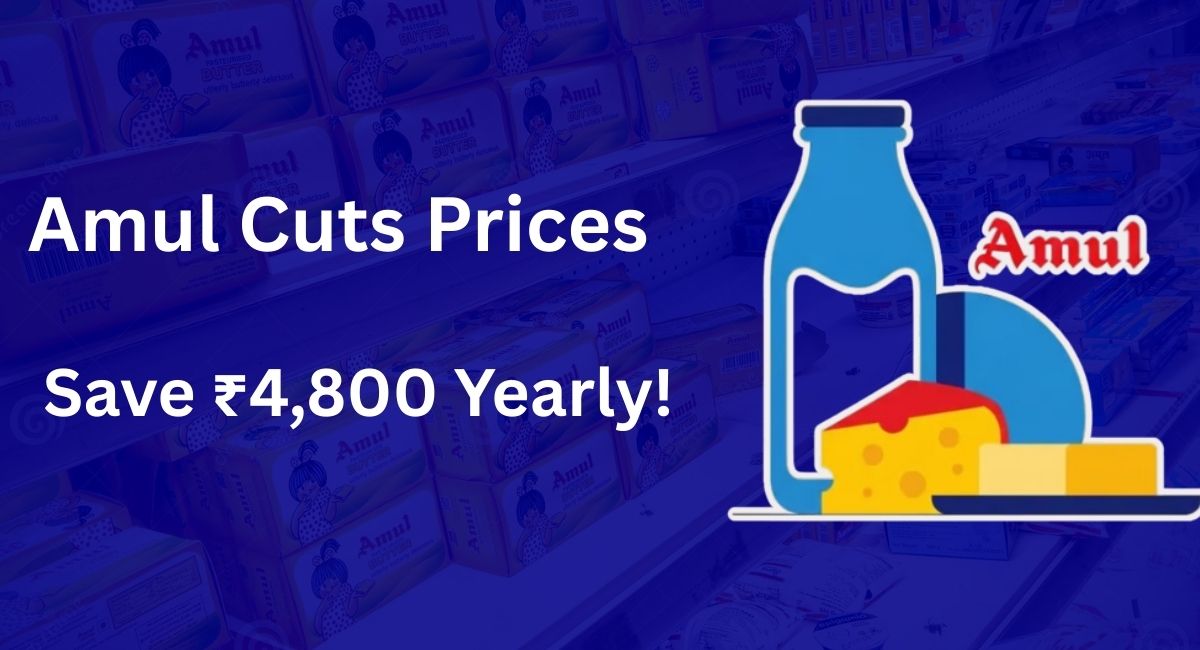The wait is finally over. The Gujarat Cooperative Milk Marketing Federation made a major move by cutting retail prices across more than 700 Amul product packs, with the new rates that took effect yesterday, September 22. This isn’t just another corporate announcement – this is real money back in your pocket.
What caught my attention immediately is how quickly major dairy companies moved to pass these savings directly to consumers. Yesterday, September 22, both Amul and Mother Dairy rolled out significant price reductions across their product lines in response to the government’s GST rate adjustments. This level of responsiveness shows the competitive pressure these companies face to maintain customer loyalty.
The Numbers That Matter Most
Here’s where this gets interesting for your household budget. The data reveals some substantial savings across everyday essentials:
Butter Takes the Biggest Hit: The MRP of butter (100 gm) has been reduced to Rs 58 from Rs 62. That’s a ₹4 reduction per pack – doesn’t sound like much until you multiply it across your annual consumption.
Ghee Prices Drop Significantly: Ghee rates have been cut by Rs 40 to Rs 610 per litre. This ₹40 reduction per liter represents meaningful savings for families who use ghee regularly.
Cheese and Paneer Get Cheaper: The MRP of Amul processed cheese block (1kg) has been cut by Rs 30 to Rs 545 per kg. The new MRP of frozen paneer (200 gm) is now Rs 95, down from Rs 99.
What stands out here is the strategic targeting. These aren’t random cuts – they’re hitting the products that middle-class families buy most frequently.
The Real Winners in This Price War
When I analyzed which product categories got the deepest cuts, the pattern becomes clear. UHT Milk: GST reduced from 5% to 0%, making it cheaper. Pre-packaged Paneer/Chhena: GST reduced from 5% to 0%. Butter, Ghee, Cheese, Dairy Spreads, Condensed Milk, Ice Cream all saw significant GST reductions.
The company isn’t hiding their strategy either. What the data shows is their belief that lower prices will drive increased consumption across dairy products, especially ice cream, cheese and butter – categories where India’s per capita consumption remains significantly below global averages, presenting substantial growth opportunities.
This tells me they’re playing a volume game – lower prices to drive higher consumption, which ultimately means more revenue even at reduced margins.
What This Means for Your Shopping List
The scope of these cuts is massive. The Gujarat Cooperative Milk Marketing Federation, which handles Amul brand marketing, rolled out price reductions across more than 700 product varieties on Saturday, covering everything from ghee and butter to ice cream, bakery items, and frozen snacks.
From my analysis of shopping patterns, most families spend ₹2,000-4,000 monthly on dairy products. These price cuts could easily save you ₹200-400 per month, which adds up to ₹2,400-4,800 annually per household.
But here’s what makes this even more significant: GCMMF, which is owned by 36 lakh farmers, directly benefits when consumption increases. This creates a positive cycle – lower prices drive higher demand, which supports more farmers.
The Strategic Play Behind the Numbers
What emerges from this move is a clear competitive response. The analysis shows that Mother Dairy had already announced similar cuts, and now Amul has matched them. This isn’t just about GST compliance – it’s about market positioning.
India’s largest FMCG brand with a turnover of ₹72,000 Crores (USD 9 Billion) in 2022-23 doesn’t make moves like this without calculating the long-term impact. They’re betting that increased volume will offset the reduced margins.
The evidence shows they’re targeting products where India has low per-capita consumption compared to global standards. Ice cream, processed cheese, and premium dairy products all fall into this category.
The Broader Economic Signal
This coordinated price reduction across major dairy brands signals something important about the current economic environment. Companies are prioritizing volume over margins, suggesting they believe consumers are price-sensitive right now.
The timing – effective September 22, 2025 – also shows how quickly companies can implement GST benefits when they choose to. This wasn’t a gradual rollout; it was immediate relief for consumers.
For investors watching the dairy sector, this move indicates intense competition for market share. Companies are willing to sacrifice short-term profitability to maintain or grow their customer base.
What to Expect Next
Based on the competitive dynamics I’m seeing, expect other major FMCG companies to follow suit with their own price reductions. When industry leaders like Amul and Mother Dairy move together, smaller players typically have to respond or risk losing market share.
The data suggests this could trigger a broader trend of companies passing GST benefits directly to consumers rather than absorbing them as improved margins. That’s ultimately good news for household budgets across India.
The real test will be whether these companies can maintain these lower prices if input costs rise due to factors like feed prices, fuel costs, or seasonal variations in milk production. But for now, your grocery budget has gotten a meaningful boost.
